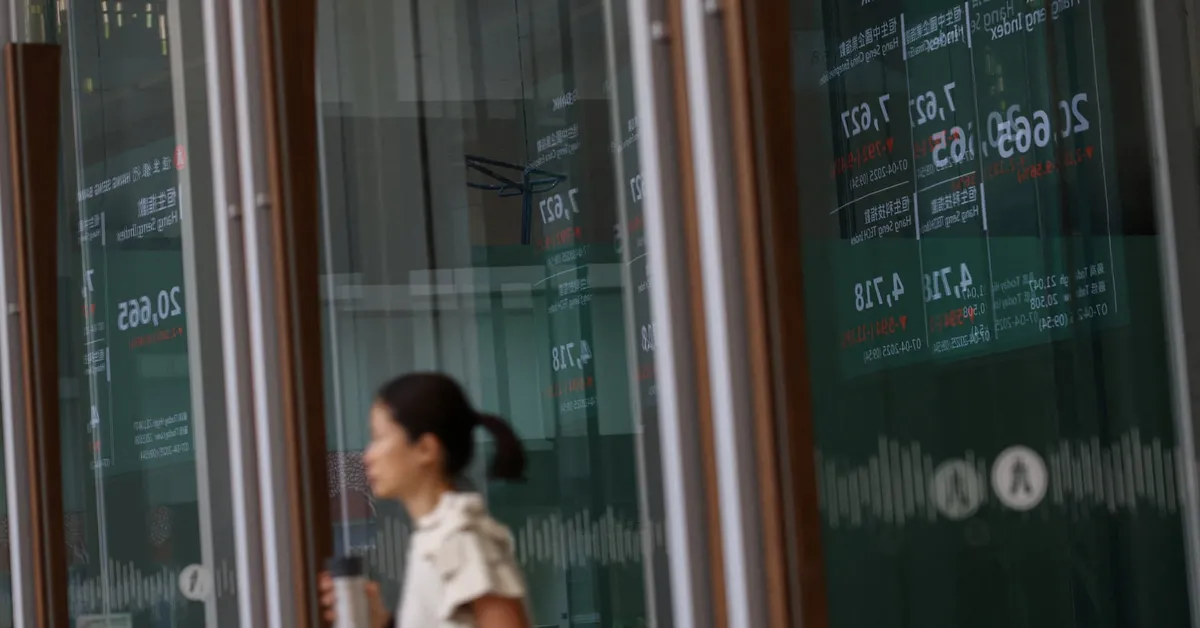
SYDNEY, May 19 (Reuters) - Asian shares experienced a decline on Monday as mixed Chinese economic data indicated that the domestic economy was facing challenges. This downturn coincides with the impact of U.S. tariffs on exports, while the White House has continued to exert rhetorical pressure on its trade partners. Wall Street share futures also showed a downward trend alongside a weakening dollar, as Treasury yields rose, highlighting concerns regarding erratic U.S. economic policies. These worries were further emphasized by Moody's recent downgrade of the country’s credit rating.
Concerns surrounding the United States' staggering $36 trillion debt have escalated, especially as Republicans push for a comprehensive package of tax cuts. Analysts estimate that this could potentially add between $3 trillion to $5 trillion in new debt over the next decade. In a series of television interviews on Sunday, U.S. Treasury Secretary Scott Bessent dismissed the downgrade while cautioning trade partners about facing maximum tariffs if they failed to negotiate in good faith. Bessent is scheduled to attend a G7 meeting this week for further discussions on trade.
In a related development, U.S. Vice President JD Vance met with European Commission President Ursula von der Leyen on Sunday to discuss trade dynamics. The future of the current 10% reciprocal tariff rate—excluding Canada and Mexico—remains uncertain. According to JPMorgan economist Michael Feroli, the effective tariff rate of approximately 13% is equivalent to a tax hike of about 1.2% of GDP. Beyond the disruptions caused by higher tariffs, the prevailing policy uncertainty is expected to further dampen economic growth.
On a European front, EUROSTOXX 50 futures saw a slight increase of 0.1%, while FTSE futures dropped by 0.1% and DAX futures remained flat. Meanwhile, U.S. indices showed declines, with S&P 500 futures falling by 0.8% and Nasdaq futures decreasing by 1.1%. This downturn follows significant gains from the previous week after President Donald Trump announced a reduction in tariffs on China.
Yields on 10-year Treasuries climbed another 5 basis points to reach 4.49%, extending Friday's reversal triggered by Moody's news. Market expectations currently indicate only 53 basis points of Federal Reserve rate cuts this year, a significant decrease from over 100 basis points just a month prior. Futures suggest a mere 33% chance of a rate move by July, increasing to 72% by September. A number of Federal Reserve officials, including influential New York Fed President John Williams and Vice Chair Philip Jefferson, are scheduled to speak this week, with Fed Chair Jerome Powell addressing the public on Sunday.
The Reserve Bank of Australia is anticipated to lower its interest rates during an upcoming meeting on Tuesday, although it is likely to signal caution about aggressive easing. Despite rising yields, the dollar continued to drift lower amidst investor concerns about the volatility of U.S. trade policies. The euro experienced a slight increase of 0.1%, reaching $1.1180, while the dollar dipped by 0.3% to 145.19 yen.
In a recent interview, European Central Bank President Christine Lagarde remarked that the dollar's recent decline reflects a waning confidence in U.S. policies, which could potentially benefit the euro. Positive sentiment surrounding the euro was bolstered by a surprising victory for the centrist candidate in Romania's presidential election, defeating a far-right, anti-EU opponent. Additionally, centrist candidates performed well in recent elections in Poland and Portugal.
In commodity markets, gold prices have rebounded after a nearly 4% drop last week, currently trading 0.6% higher at $3,222 an ounce. Conversely, oil prices faced challenges due to concerns over potential increased output from OPEC and Iran. As a result, Brent crude edged down by 19 cents to $65.22 a barrel, while U.S. crude saw a minor decline of 15 cents, settling at $62.34 per barrel.
Reporting by Wayne Cole; Editing by Jacqueline Wong and Christopher Cushing.